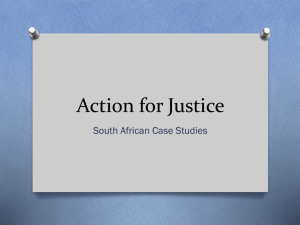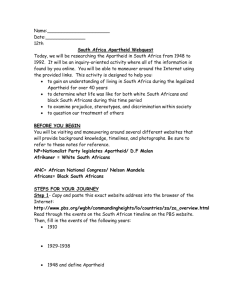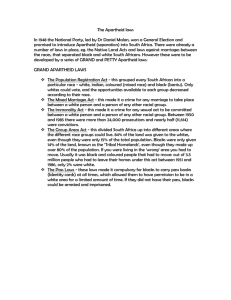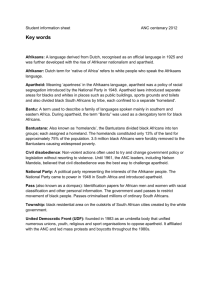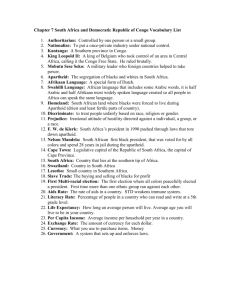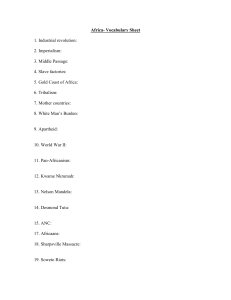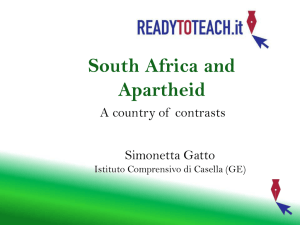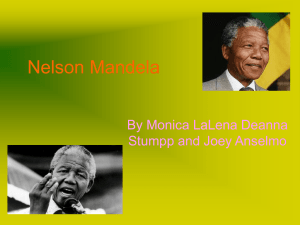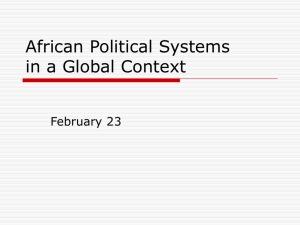South Africa PowerPoint - Paulding County Schools
advertisement
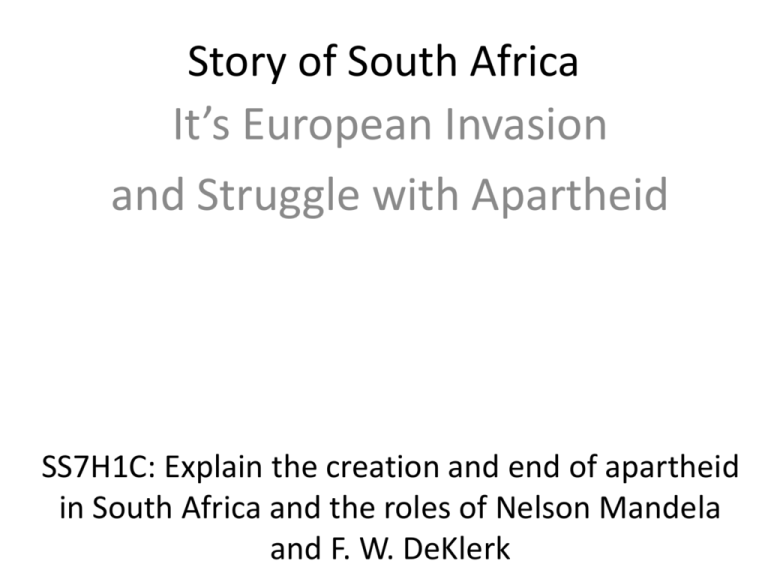
Story of South Africa It’s European Invasion and Struggle with Apartheid SS7H1C: Explain the creation and end of apartheid in South Africa and the roles of Nelson Mandela and F. W. DeKlerk • • • • Essential Questions??? What events led up to apartheid? What is apartheid? What was its purpose? How were the black South Africans treated and how does it compare to the treatment of the black Americans prior and during the Civil Rights Movement? • How did apartheid impact the standard of living of black South Africans in contrast to the standard of living of white South Africans? Brief History of South Africa (not testable material) • Prior to 1650, the Dutch made money through the West African Slave Trade. When Great Britain began to outlaw purchasing slaves from West Africa (1650), they turned to setting up trade posts in South Africa in 1652. • Over time they considered themselves more African than European and called themselves Afrikaners. They considered themselves superior to native Africans (Ethnocentric) and used them as slaves until the early 1800s when the British took control of the Cape Colony and abolished slavery. • The Afrikaners were originally called Boers (“farmers”) because many Dutch settlers of the old Cape Colony became frontier farmers. • Pushed native agrarians, pastoralist, and hunting/gathering people off their lands! • They established communities, developed their own language and were committed to a policy of apartheid. 3 generations of Boers Early 1800s in Southern Africa • After defeating the black South Africans, the Afrikaners had migrated north of the Orange River, known as the Great Trek, due to the British presence in the Cape Colony. The British were colonizing! • The British originally came to this area as a trade post (restocking before going to India) but started settling. • Large quantities of gold were found by the Afrikaners along with the British discovering diamonds in southern Africa in 1867. • The riches, along with the colonial movement in general, led to the British fighting for land during the Boer War of 1899-1902. Queen Victoria's diamond from the Transvaal Today much of the country's economic wealth still remains in Afrikaner hands. • Native Africans fought alongside the British due to their anti-slavery attitude. • The British won the Boer War and established the Union of South Africa in 1910. • Even though it was a republic, the Afrikaners had less rights than the British, but the black South Africans had no rights under the British government, similar to how the North treated the South in the American Civil War. Boer War Afrikaners /Boers What is Apartheid? Video Link • The term apartheid (from the Afrikaans word for "apartness") was created in the 1930s and used as a political slogan of the National Party in the early 1940s, but the Dutch had been ethnocentric since they settled in 1652. • After the Afrikaner Nationalists outvoted the British and came to power in 1948, apartheid was implemented under law. • The implementation How did the new of the policy, later referred to as government enforce "separate this new policy? development," was made possible by the Population Registration Act of 1950, which put all South Africans into four racial categories: Bantu (black African), White, or Coloured (of mixed race), and Asian (Indians and http://overcomingapartheid.msu.edu/video.php?id=65-24F-DD Pakistanis). Afrikaner Nationalists’ policies 1. The system of apartheid was a series of laws passed in the 1950s: the Group Areas Act of 1950 assigned races to different residential and business sections in urban areas http://overcomingapartheid.msu.edu/video.php?id=65-24F-7D 2. The Land Acts of 1954 and 1955 restricted nonwhite residence to specific areas. These laws further restricted the already limited right of black Africans to own land, entrenching the white minority's control of over 80 percent of South African land. http://overcomingapartheid.msu.edu/video.php?id=65-24F-38 Other laws prohibited 3. most social interaction between the races; 4. enforced the segregation of public facilities, including 5. educational; 6. created race-specific jobs; 7. limited the powers of nonwhite unions; and 8. minimized nonwhite participation in government. A girl looking through a window of her shack in Cross Roads, 1978. It is illegal to move out of your homeland and to build your own non-government issued home. Show opening scenes of Cry Freedom Segregated public facilities in Johannesburg, 1985. What details do you notice in the picture? More Restrictions!!! • 9. The Bantu Authorities Act of 1951 and the Promotion of Bantu Self-Government Act of 1959 furthered these divisions between the races by creating ten African "homelands“ to be self-governed by the various “tribes.” • 10. The Bantu Homelands Citizenship Act of 1970 made every black South African a citizen of one of the homelands which eliminated black Africans from South African politics. (Took away their citizenship.) • Can’t vote, can’t sue, can’t testify or defend in court! Other Laws… • • • • 11. Illegal to be homeless. 12. Illegal to not have a job. 13. Illegal not to go to school up to a certain age. 14. Starting in 1962, legal to imprison someone indefinitely without being charged with a crime. – http://overcomingapartheid.msu.edu/video.php?id=65-24F-DC • 15. People accused of being a political activist or a “terrorist” could be imprisoned or banned. • 16. Bantu had a curfew and had to have permission from their employer to be out of the homeland after dark. • 17. Cannot change houses or live with a relative without registering with the government. 18. Must carry a passbook at all times with correct name, address, homeland AND employer info. A Black South African shows his passbook issued by the Government. Blacks were required to carry passes that determined where they could live and work. https://www.youtube.com/watch?v=K9xmQ4U6Cw0 http://overcomingapartheid.msu.edu/video.php?id=65-24F-5C A segregated beach in South Africa, 1982. Houses in Soweto, a black township in the “homelands.” Young, black South Africans looking in on a game of soccer at an allwhite school in Johannesburg. Government spending, about 10 times more for white children than for black, clearly showed the inequality designed to give whites more economic and political power. Poorly trained teachers, overcrowded classrooms, and inadequate recreational facilities were normal for black children, if in fact they had any schooling available at all. Young coal miners in South Africa in 1988. The numbers don’t lie . . . Blacks Population 19 million Whites 4.5 million Land allocation 13% 87% Share of national income <20% 75% Minimum taxable income 360 rands 750 rands Doctors/population 1/44,000 Infant mortality rate 20%-40% 2.7% Annual expenditure on education per student $45 $696 1/60 1/22 Teacher/student ratio 1/400 A number of black political groups were created, such as the African National Congress (The ANC) Nelson Mandela was a leader in this group. He encouraged Non Violent protest. These political groups were often supported by sympathetic whites, opposed apartheid using a variety of tactics, including violence, strikes, demonstrations, and sabotage - strategies that often met with severe consequences from the government. http://overcomingapartheid.msu.edu/video.php?id=65-24F-DC Grave of the young Black leader, Steve Biko, in King Williams Town, South Africa. Biko died while in prison in 1977. During the investigation into his death, strong evidence was presented that Biko suffered violent and inhumane treatment during his imprisonment. Show end credits of Cry Freedom Assessment 1: Create a protest poster. • You are a black South African and you are protesting against Apartheid. • On your poster tell 4 things that the Afrikaners are doing that are restricting your rights as a black South African. (25 points for each correctly explained event/right.) • Include an illustration of each event. Make it colorful and creative! You want to draw people’s attention. • Due: ____________________ SS7E2B: Describe a trade barrier that effected the economy of South Africa • What is a sanction? • Why did foreign countries impose sanctions on South Africa? • How did foreign countries hurt South Africa’s economy with sanctions. SS7H1C: Explain the roles of Nelson Mandela and F.W. DeKlerk in South Africa • What did F.W. DeKlerk and Nelson Mandela do to end apartheid? • What were their roles in the new government? SS7G2C: Students will explain the structures of the modern governments of Africa •What was the government of South Africa like after the abolishment of Apartheid? Key word is “selective” • Apartheid was also denounced by the international community: in 1961 South Africa was forced to withdraw from the British Commonwealth (kicked out of the United Kingdom). • In 1985 the governments of the United States and Great Britain imposed selective economic sanctions on South Africa in protest of its racial policy. Ex: Coca Cola, Kodak, IBM International Economic Sanctions worked! As anti-apartheid pressure mounted within and outside of South Africa, the South African government, led by President F. W. de Klerk, (white) began to dismantle the apartheid system in 1989. • The year 1990 brought a National Party government dedicated to reform and also saw the legalization of formerly banned black congresses (including the ANC—African National Congress) and the release of imprisoned black leaders. https://www.youtube.com/watch?v= KZwRpwXOq78&list=PL694FVKTtFvLz UsNqc9S424ZWq60arlYa&index=3 Trailer for Mandela and de Klerk https://www.youtube.com/watch?v=HHqi 6ZB_F0U Reconciliation: Invictus • In 1994 the country's constitution was rewritten and free general elections were held for the first time in its history, and with Nelson Mandela's election as South Africa's first black president, the last remnants of the apartheid system were finally outlawed. https://www.youtube.com/watch?v=J34VyWDnh-Q Mandela and de Klerk running for election http://www.youtube.com/watch?v=p-qwSVTpiMM interview with deKlerk. Doesn’t apologize for apartheid. South Africa’s Government Today Read Page 563 • South Africa is now a Republic • The president is elected by all citizens (black, white, Asian, mixed) for 5 year terms. All citizens over the age 18 are allowed to vote • The Legislature is bicameral and is elected by the citizens. SS7G4C: Evaluate how the literacy rate affects the standard of living • How did denying black South Africans the same education during apartheid impact today’s South African economy and standard of living? • The country is still dealing with social difficulties among the black population, such as education/literacy rate, quality of jobs, overall standard of living Soweto today: http://www.youtube.com/watch?v=FSQPbbVtU8 http://www.youtube.com/watch?v=jj84Sw1x2po

